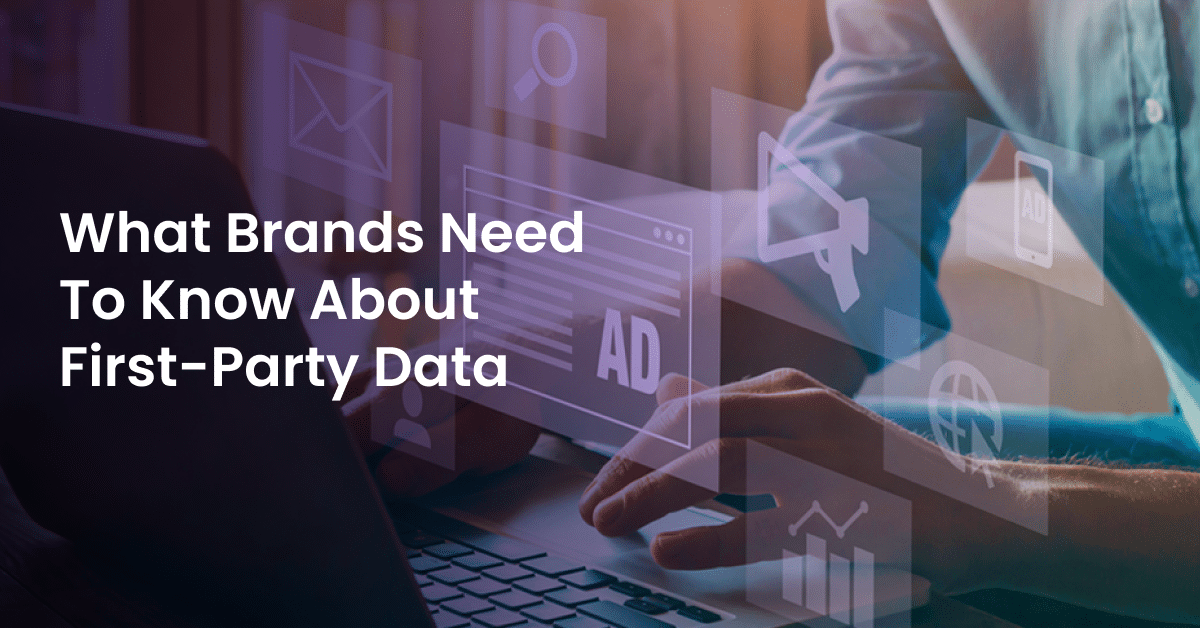

First-party data is quickly becoming the new opportunity to fuel personalization, customer engagement and online growth. Publishers are already starting to use first-party data to deliver customized experiences to their audience. For retail and ecommerce brands, there’s a tremendous opportunity to grow with first-party data.
What Is First Party Data Anyway and Why It Matters
The best way to explain first party data is through a quick story. Imagine you’re running digital marketing at an apparel company and you’re looking for ways to sell more shoes this quarter. You have many different options and resources to choose from. One decision you’ll have to make upfront is what kind of data to leverage.
Consider planning your campaign by reviewing past customer activity. For example, you may look at website analytics to see which product pages are already receiving the most traffic. In addition, ask your customer service colleagues to summarize what kind of questions and complaints you get. All of this data comes directly from your customers, website visitors, and email subscribers. That’s all first party data.
First party data is often contrasted with another popular type of marketing data: third party data. For many years, digital marketers have used third party data for growth. Third party data is customer data generated by other companies. While this type of marketing data is popular, it’s becoming less useful for two reasons.
There are two reasons why companies are moving away from third party data. First, it is less transparent to consumers and can result in negative feedback. Second, Google and Apple are ending support for third party cookies (a popular technology that enables many third party marketing campaigns) in their browsers.
First party data has multiple applications regardless of how you sell products. Let’s take a closer look at some of the most powerful use cases.
Retail and Ecommerce Use Cases For First Party
At its simplest, first party data is data that you gather directly from your customers, website visitors and others who interact with your brand online. Leveraging first party data makes it easier to achieve several sales and marketing goals.
Achieving Marketing Goals With First-Party Data

Systematically using first party data makes it easier to achieve your digital marketing growth goals.
Optimize Your Content Marketing Efforts
First party data tells you what content, links and assets your audience finds the most engaging. For example, start your analysis by reviewing your top 10 pages by traffic for the past 90 days. Ideally, focus on the pages that have driven the most conversions (e.g. purchases, website signups etc).
Based on what you find, you can make better decisions about your content marketing strategy. An athletic apparel ecommerce company might find that their ultimate guide for marathon running drives the most conversions. Based on that insight, you may create more content to attract marathon runners to your website.
Reduce Digital Marketing Expenses
Success in digital marketing requires the patience to experiment with new ideas, technologies and campaigns. The downside is that many marketing tests may not deliver significant results. When marketing budgets come under pressure, you may be asked to stretch your marketing dollars further. First-party data can play a powerful role in lifting marketing efficiency in the following ways.
Optimize Referral Campaigns
Word-of-mouth referrals are one of the most powerful ways to grow online. That said, sending out a blast message to your entire database is unlikely to work.
It’s far better to focus referral campaigns on your VIP customers – the ones who buy over and over again. First party data can help you identify your best customers which means you can create a far more targeted referral campaign.
Boost Loyalty Marketing Efforts
Many retail companies have loyalty programs because these efforts effectively encourage repeat business. The data you gather from buyers through your loyalty program is one of the most valuable forms of first party data.
Analyze the buying patterns of your top customers and then use those patterns to inform your new campaigns. For example, you may find that 80% of repeat shoppers start by buying low-priced products. Use that insight and prepare a loyalty campaign to encourage one-off buyers to buy that product.
Increasing referrals and loyalty sales don’t require additional advertising so they’re a great choice when budgets are tight. You just need to focus on analyzing your customer data and executing campaigns based on those insights.
Achieving Sales Goals With First-Party Data

Some businesses are not focused on online sales. For example, industrial products, vehicles and enterprise software are rarely bought in a matter of clicks. In these more complex sales, first party data can support your sales goals.
Identify High Interest Sales Leads
Sales professionals only have so many hours in the day. First party data can play a role in lifting the efficiency of sales conversations. An analysis of first-party data can identify the prospects who are the most engaged with your content and may be open to a sales call.
Earn Attention With Relevant Content
Complex sales can take weeks, months or even years to close. Staying in touch with prospects during these longer customer journeys takes a lot of work! You can only send a “checking in” style email so many times.
First party data can support the nurturing process. You can see which content your customers access in the lead up to purchase and afterward. As a result, you can craft follow up messages focused specifically on content that resonates with buyers.
From First-Party Data To Deeper Engagement
Simply gathering and using first party data will give you an immediate advantage in making sales and reaching your marketing goals.
Ultimately, your goal isn’t really focused on getting data (even highly useful data like first party data). You want to build an audience of people who look forward to visiting your website regularly. An audience who finds insights, connections and experiences all through your company is one that will stay loyal.
The secret to gaining first party data and deep engagement requires the right technology. That’s where Arena Live Chat technology comes in. You can install it in just a few minutes and get up and running. Discover more about how Arena can help you grow ecommerce revenue!



